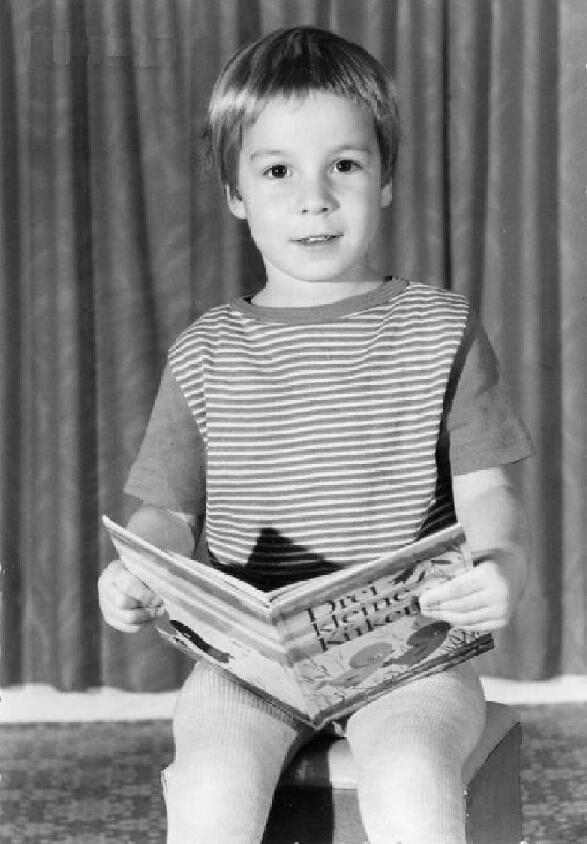
German Boys' Hosiery: Clothing

Figure 1.--Younger boys during the winter might wear tights without pants. This German boy we think in the early-70s looks to be at a pre-school. Somewhat older boys might wear tights at home in the evening. A reader tells us, "The title of the book this little boy is reading is 'Drei kleine Küken'. That means "Three little chicks".
|
|
There are associations between cerain types of hosiery and pants. This has changed over time. Kneepants suits were mostly worn with long stockings, although there was some seasonal and functional variation. Knicker suits by the 1920s and short pants suits were also worn with long stockings, but kneesocks became much more common. Styles of hoiery for Ledehosen were more varied. Knee socks were probably most common, but there was a kind of calf band that was worn in some areas when wearing folk costume. As long pants became mnore commn, boys mostly wore ankle socks, although some boys wore long stockings in cold weather. As tights were introduced in the late 1950s, we note various conventions. Younger boys might wear the with shorts, but lng pants were becoming more common. So some boys woe them with long pants. Tights introduced novel approaches. Boys in pre-school might wear them without pants (trousers). Even older boys at home migt do the same. We note the same conventions in other countries where tights were worn like Russia.
Shirts
Shirts at first glance did not did not affect hosiery, but this is not entirely true. Here the overall outfit is probably at play. Boys formally fssed wearing a blouse or white shirt might wear white knee socks. Boys wearing an informal "t"-shirt duing the summer robably wore ankle soicks. Her factors like age and chronlogical period also affected choices.
German boys have worn a variety of hosiery with suits. There are associations between cerain types of hosiery and pants. This has changed over time. We are less sure what boys wore with long pants which were widely worn throughout the 19th century. As younger boys began to wear shotened-length pants at mid-century, avaialble photographic images show German boys wearing a range of socks and long stockings. We mostly see boys wearing long stockings with kneepants in the 19th century, although there was some seasonal and functional variation. We aldo see bloomer knickers and they were akso worn with long stockings. By the 1890s an increasing number of boys and older boys were wearing kneepants. This trend continued into the 20th century. We begin to see short pants suits in the 1910s. After World War II, this trend continued, although at first short pants were very long. . Kneesocks were always worn with knickers and usually with short pants suits. We have not noted German boys commonly wearing short pants suits with short socks until the 1960s. Knicker suits by the 1920s and short pants suits were also worn with long stockings, but kneesocks became much more common. Some younger boys wore short pants suits with long stockings. This was most common during the winter in cold weather. A good example is an unidentified German boy, probably in the 1930s. While German boys most commonly wore long stockings for warmth, they were also wore long stockings for dress occasions such as First Communions or Confirmations. We note that black long stockings and white knee socks were sometimes worn with suits for formality. Styles of hoiery for Ledehosen when worn with suit jackets were more varied. Knee socks were probably most common. After the 1960s, long pants suits became increasingly common making it difficult to determine the hosiery type. As best we can tell, tights were not commonly worn with suits. This is in part because as tights were becoming popular, short pants suits were becoming less popular. Another factor us that German boys by the 1970s were not wearing suyits as commonly as they did earlier.
Folk Outfits
There was a kind of calf band that was worn in some areas when wearing folk costume.
The type of pants probably had more impact on hosiery than any other garment. Here we have the complicating factor that it is difficult to tell what kind of hosiery boys in long pants are wearing. Boys commonly wore long stockings or knee sockswith knee pants. We see boys in short pants wearing quite a range of hosiery. This was affected by age, chronology, formality, as well as fmily and individual preferences. As long pants became mnore commn, boys mostly wore ankle socks, although some boys wore long stockings in cold weather. As tights were introduced in the late 1950s, we note various conventions. Younger boys might wear the with shorts, but lng pants were becoming more common. So some boys woe them with long pants. Tights introduced novel approaches. Boys in pre-school might wear them without pants (trousers). Even older boys at home might do the same. We note the same conventions in other countries where tights were worn like Russia. Boys also wore knee pants with various types of hosiery. We note long stockings, however, seem particularly common with knee pants. Ankle socks and tights were not worn with knee pants. Knickers were not as common for German boys, but they were worn, mostly with long stockings or knickers.
Footwear
HBC

Navigate the Boys' Historical Clothing German pages:
[Main German hosiery page]
[German choirs]
[German movies]
[German royalty]
[German school uniforms]
[German youth groups]
[German sailor suits]
[Lederhosen]
[Ethnic]
[Tights]
[Long stockings]
Navigate the Boys' Historical Clothing Web Site:
[Introduction]
[Activities]
[Biographies]
[Chronology]
[Clothing styles]
[Countries]
[Bibliographies]
[Contributions]
[FAQs]
[German glossary]
[Images]
[Links]
[Registration]
[Tools]
[Boys' Clothing Home]
Created: 1:24 AM 4/23/2008
Last updated: 5:24 AM 8/17/2010



